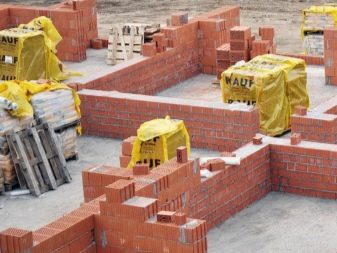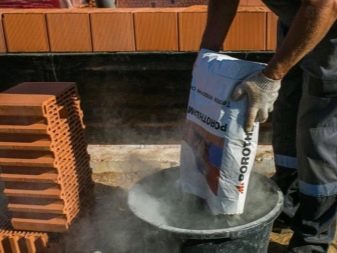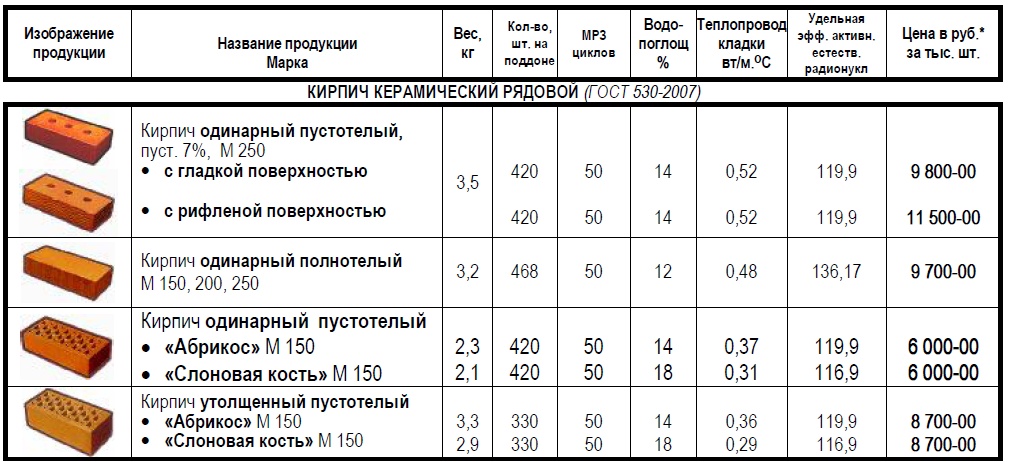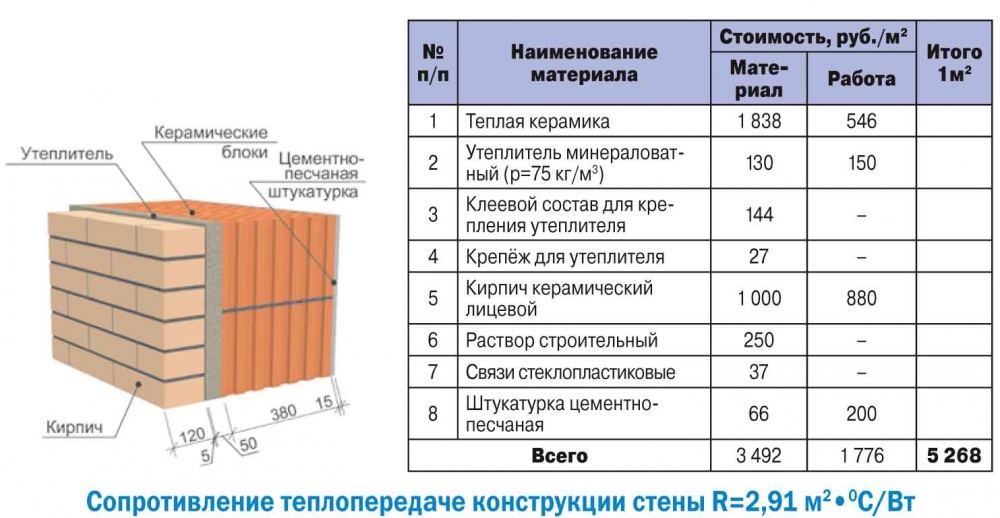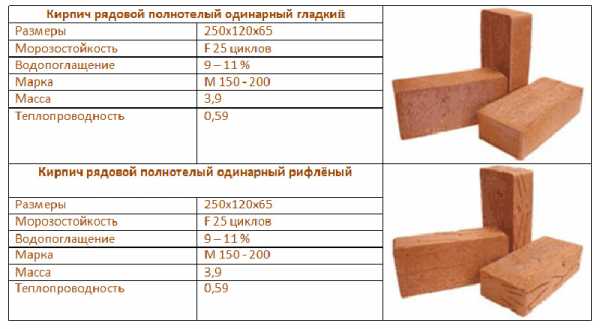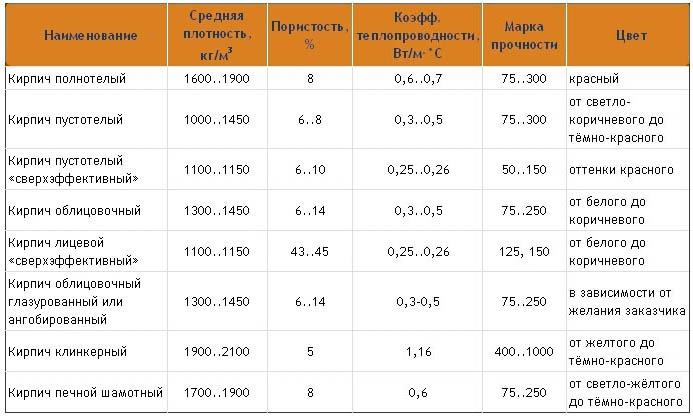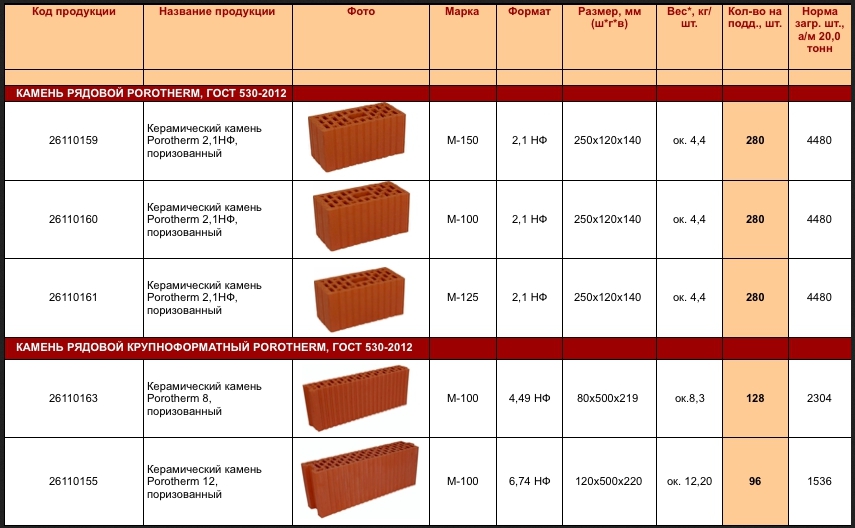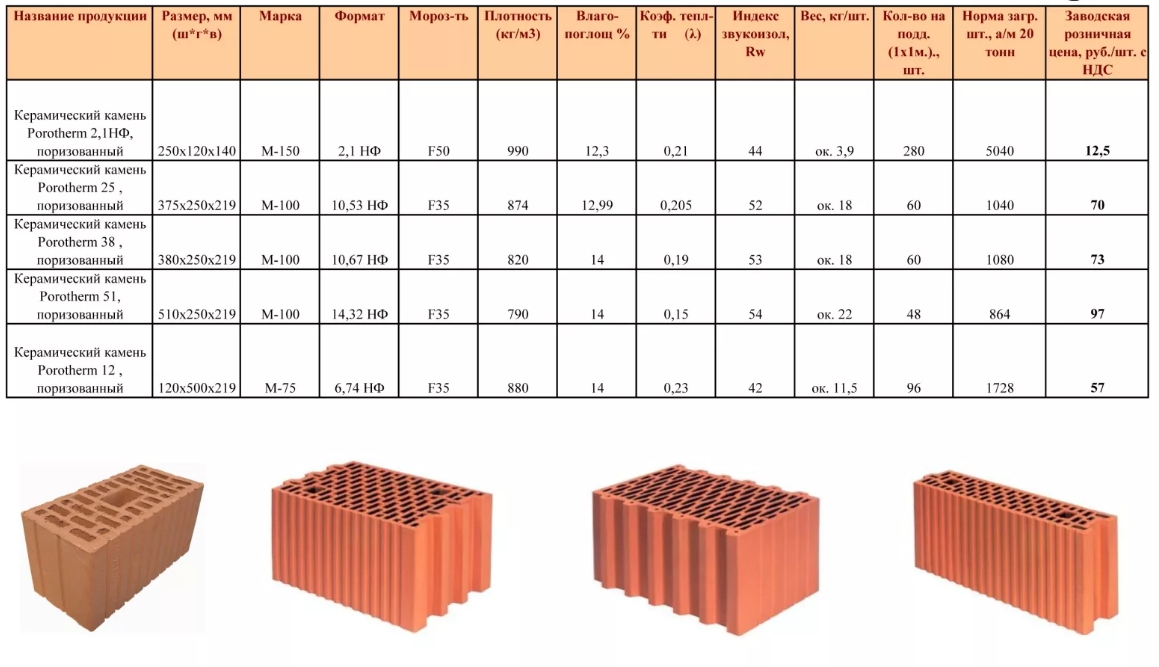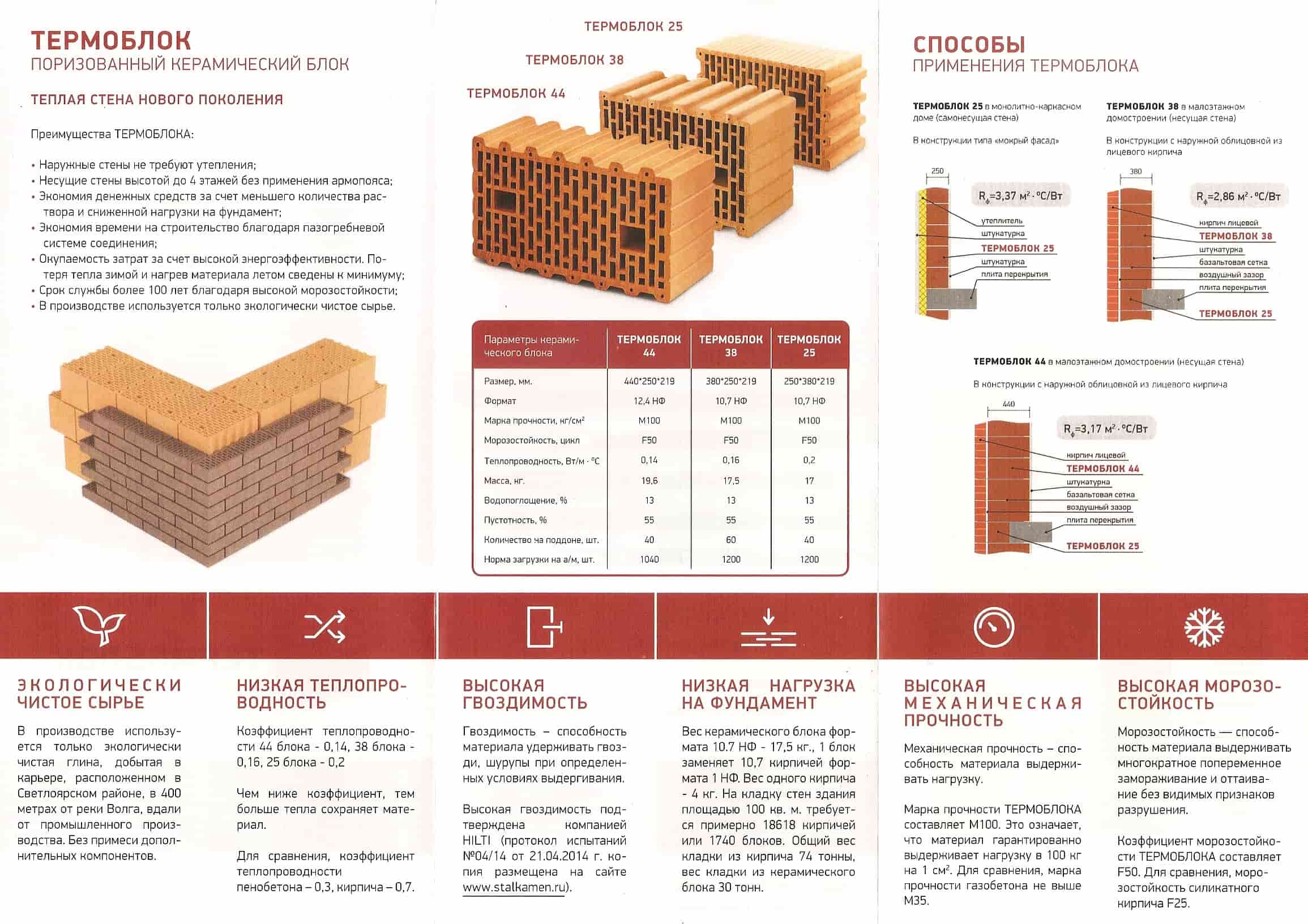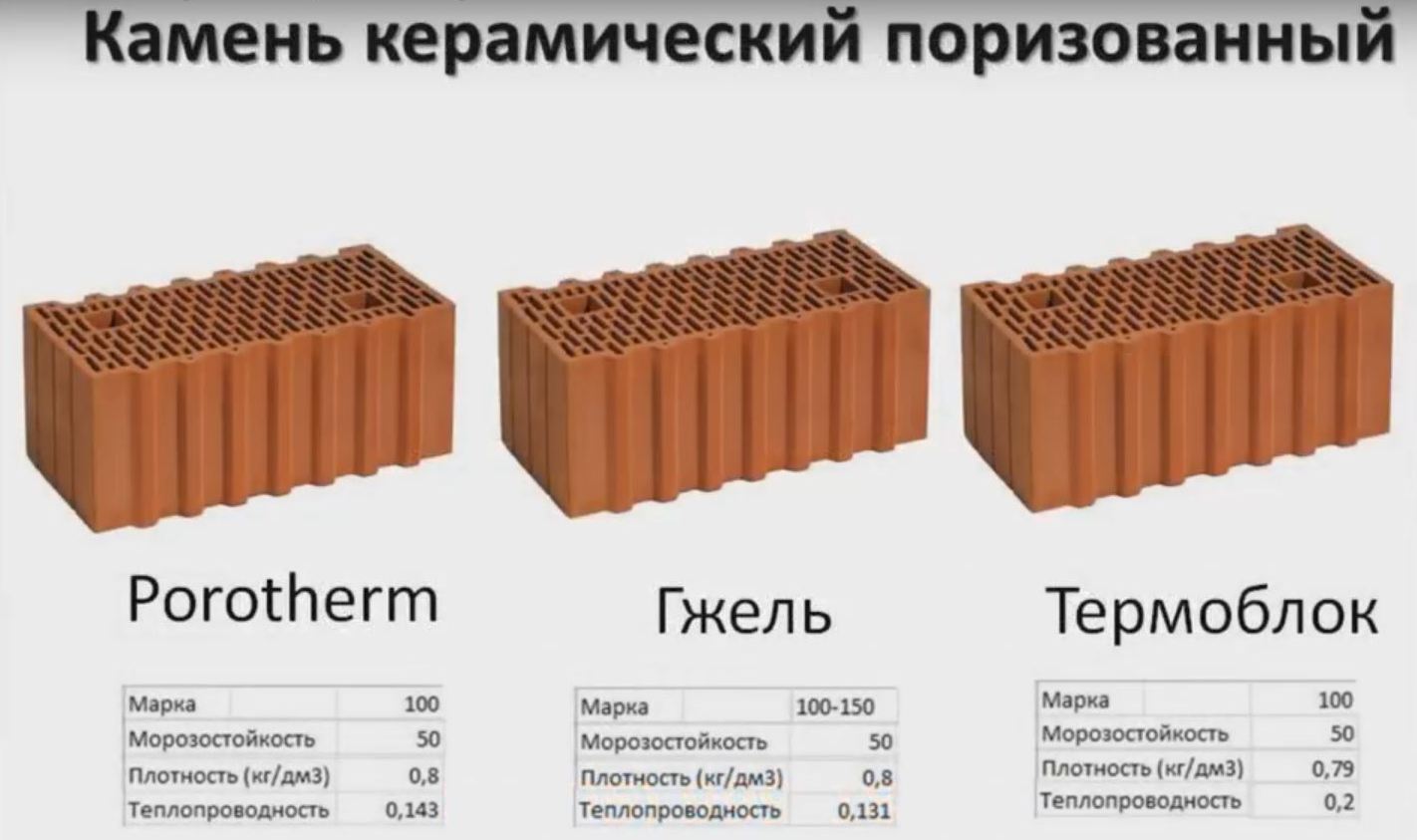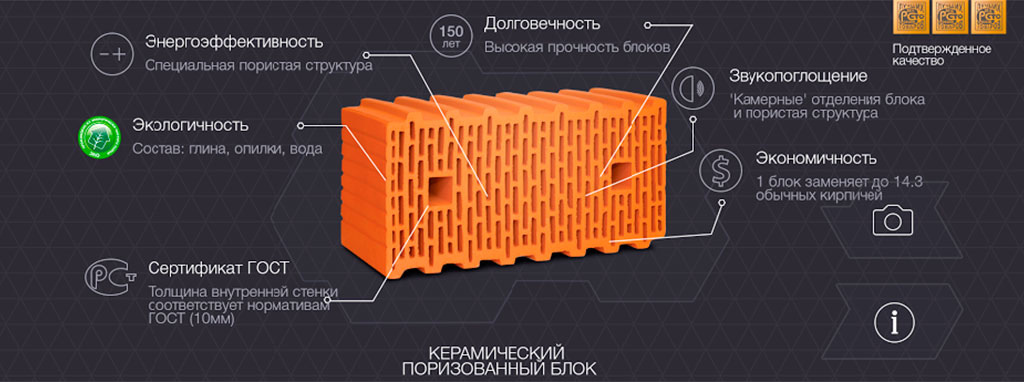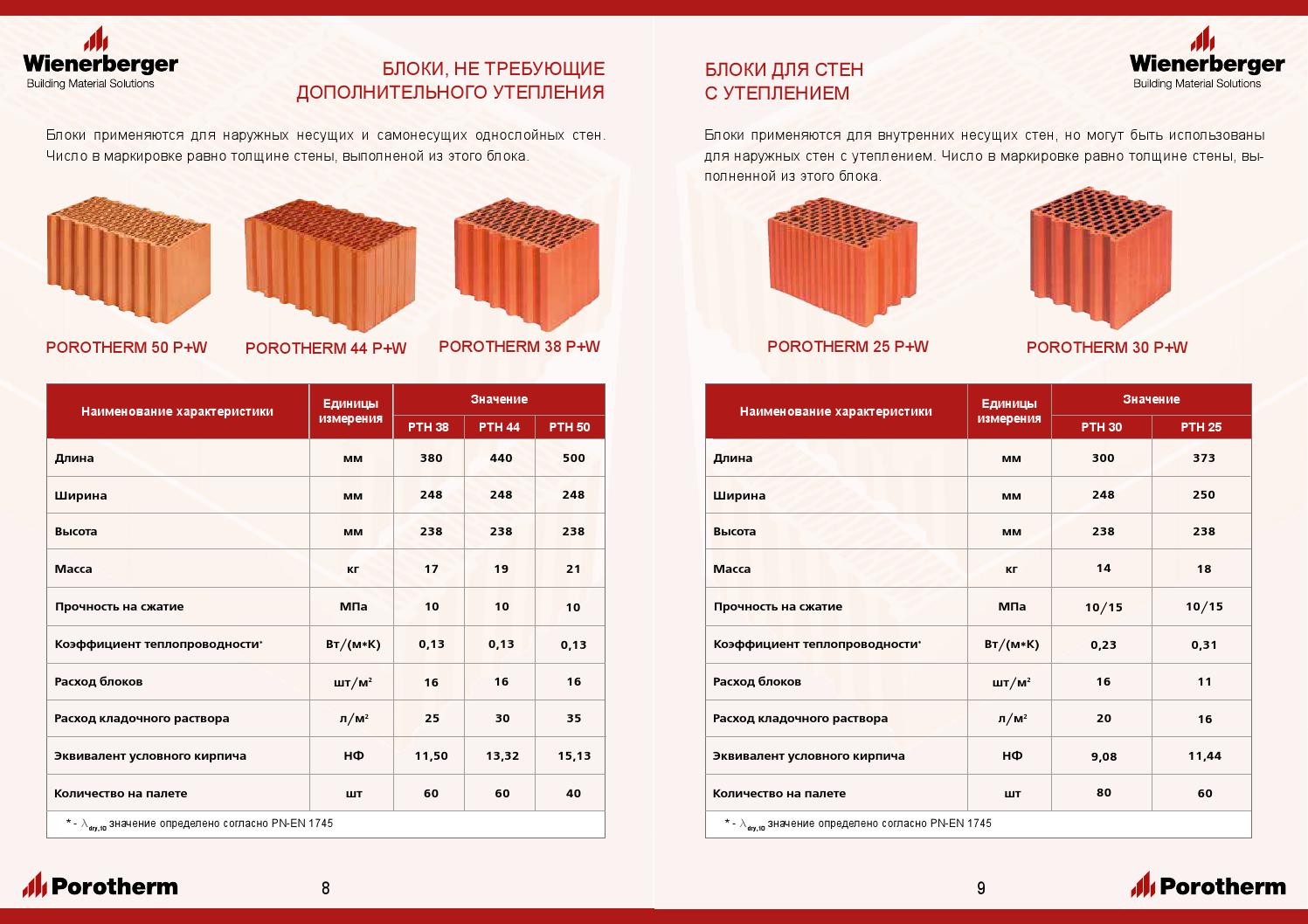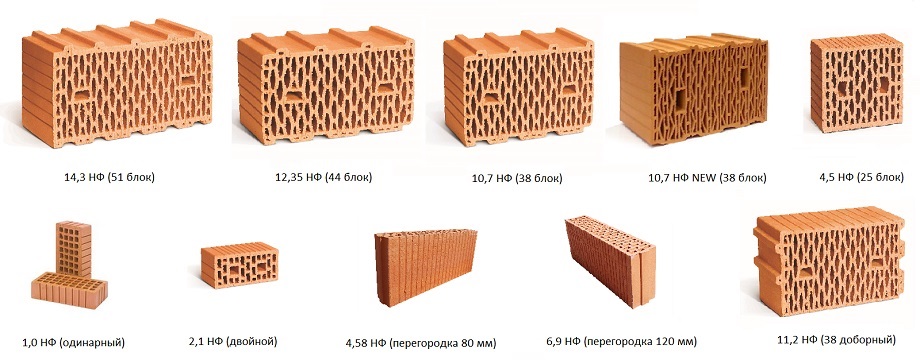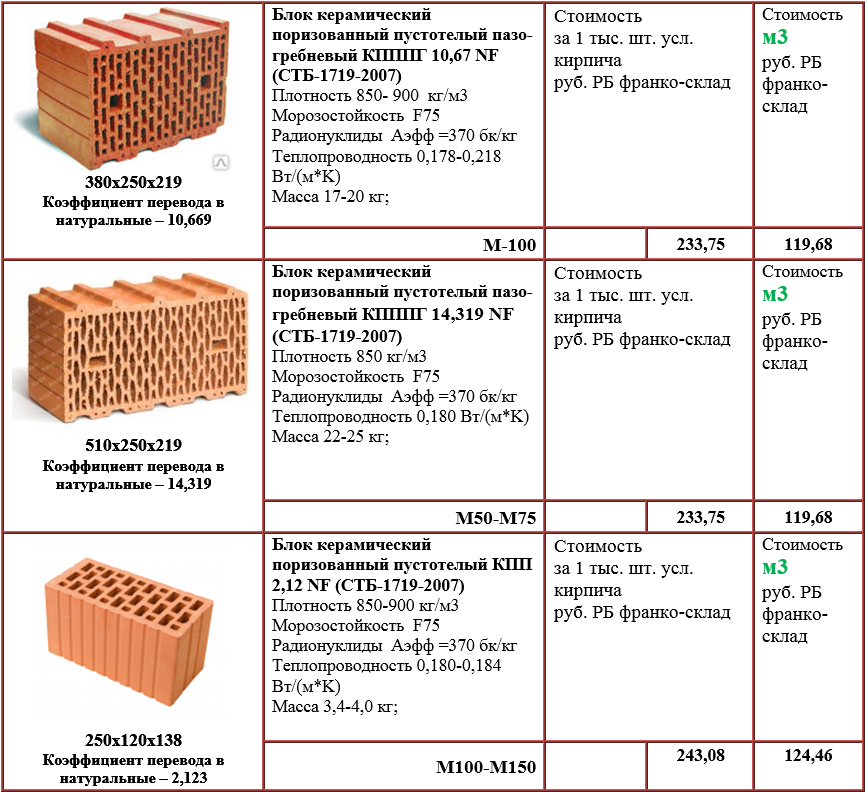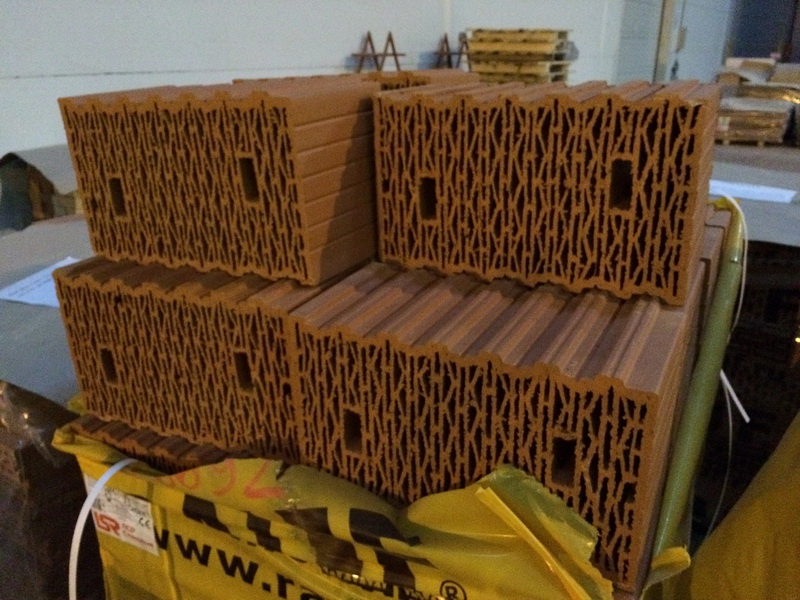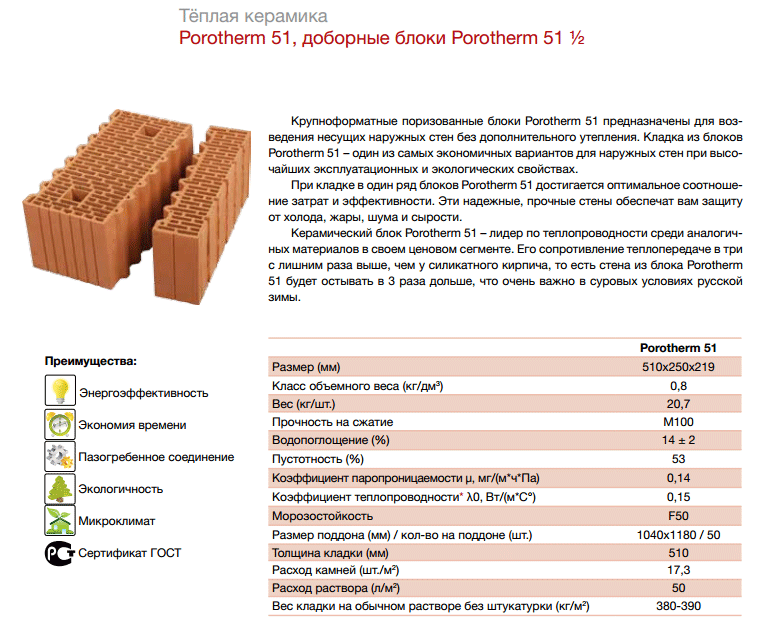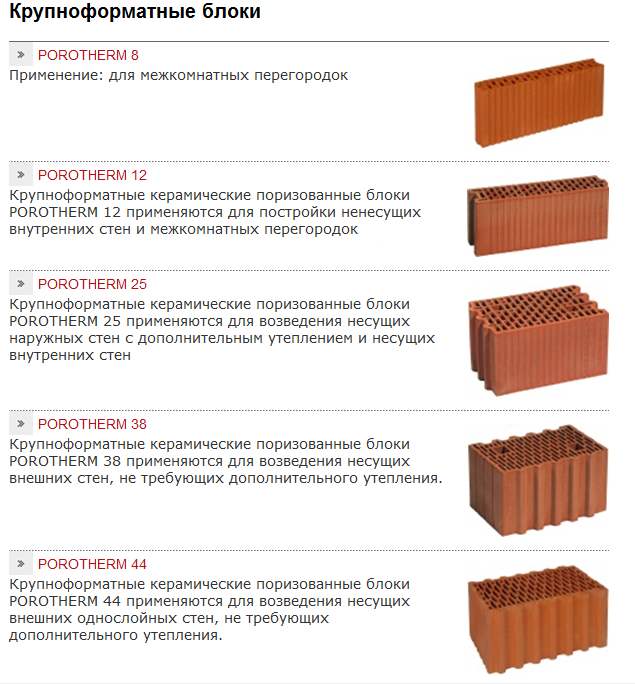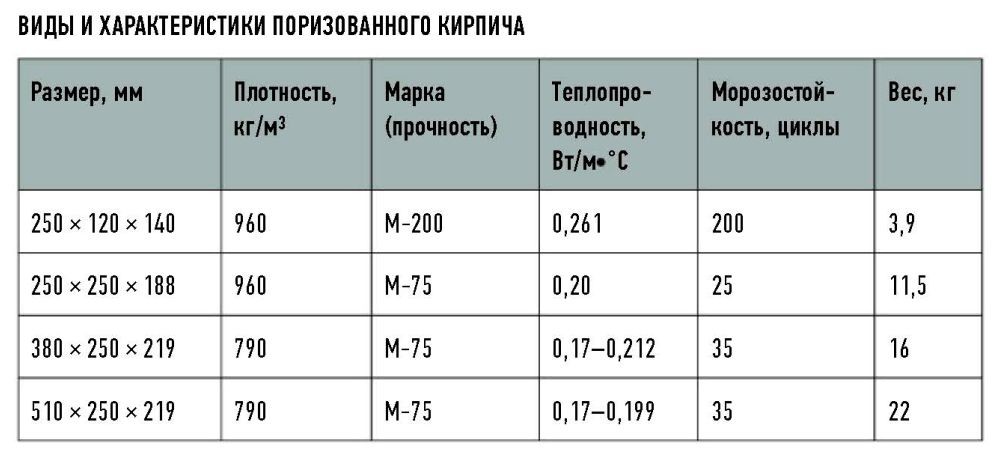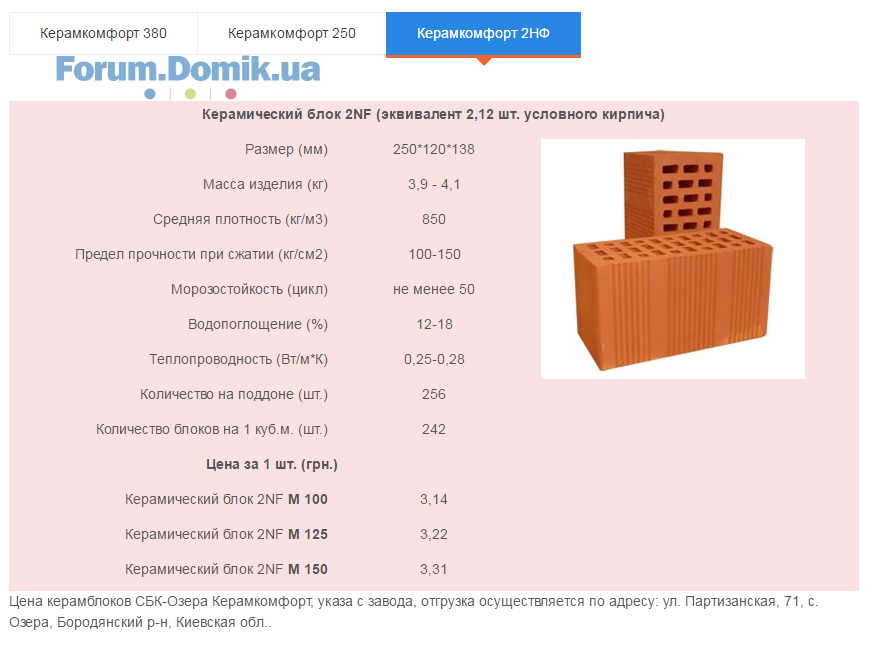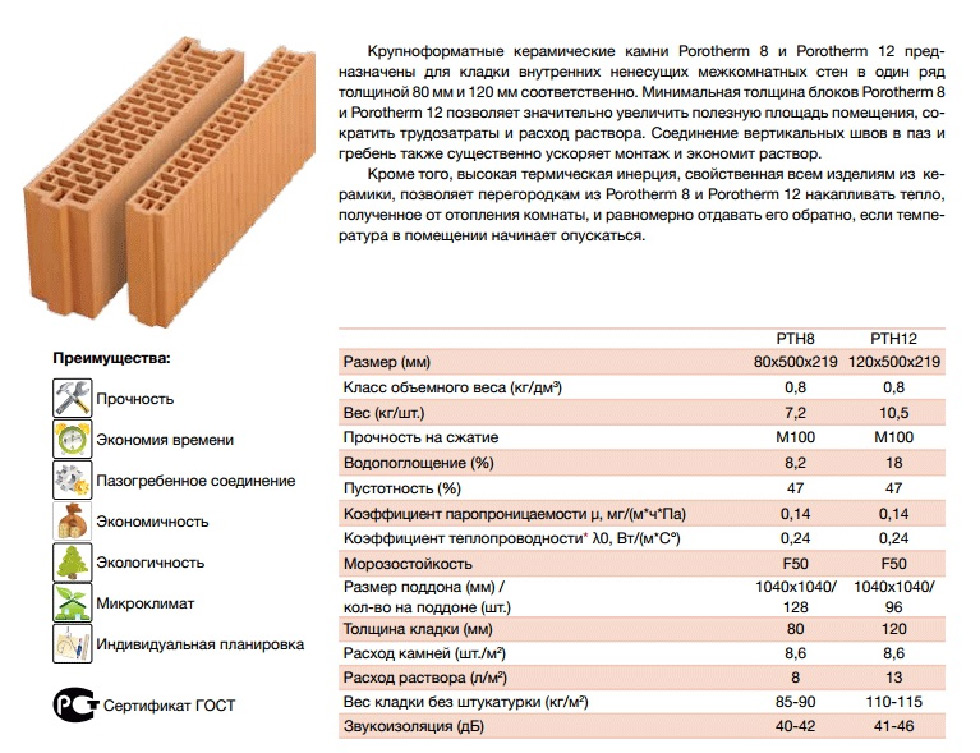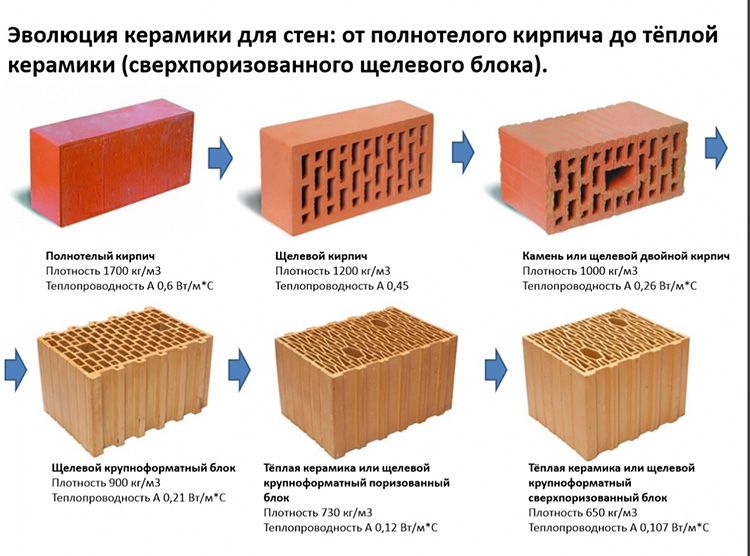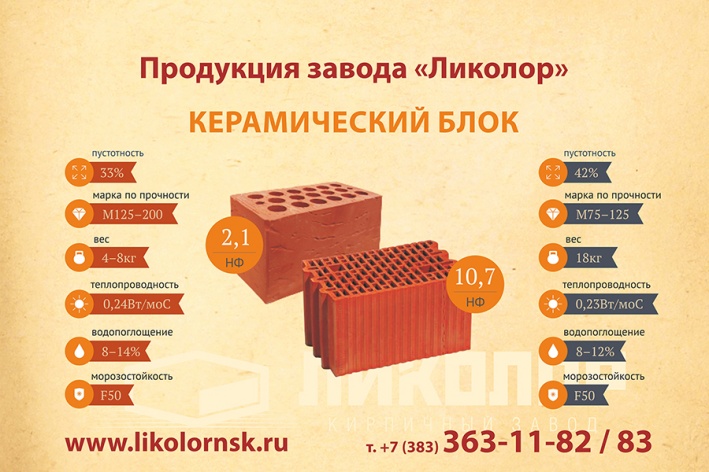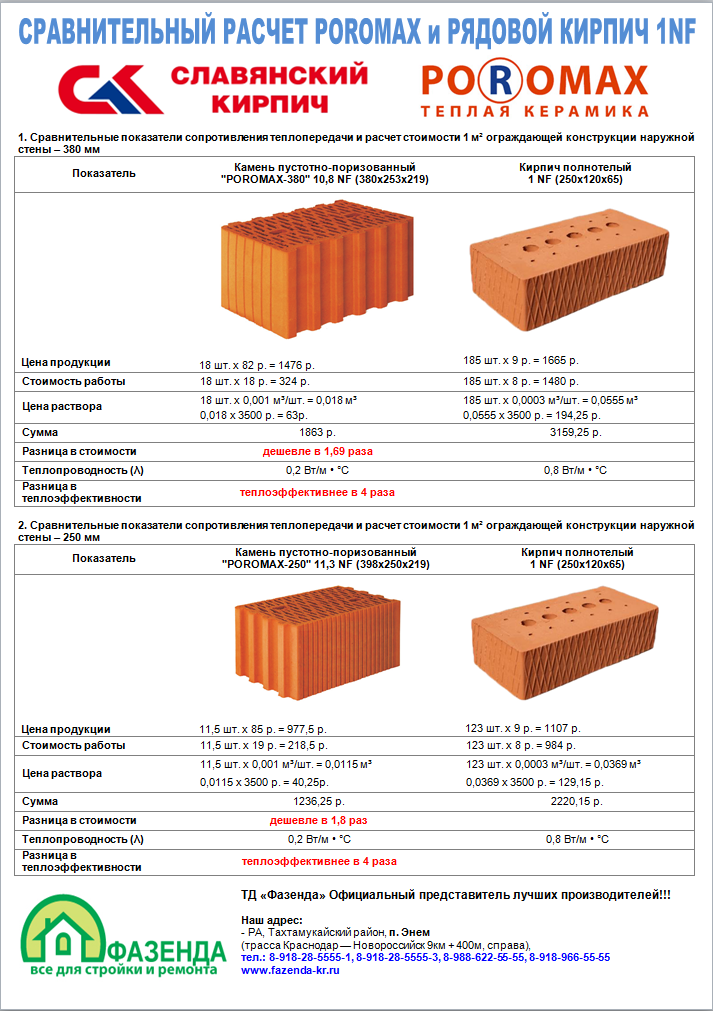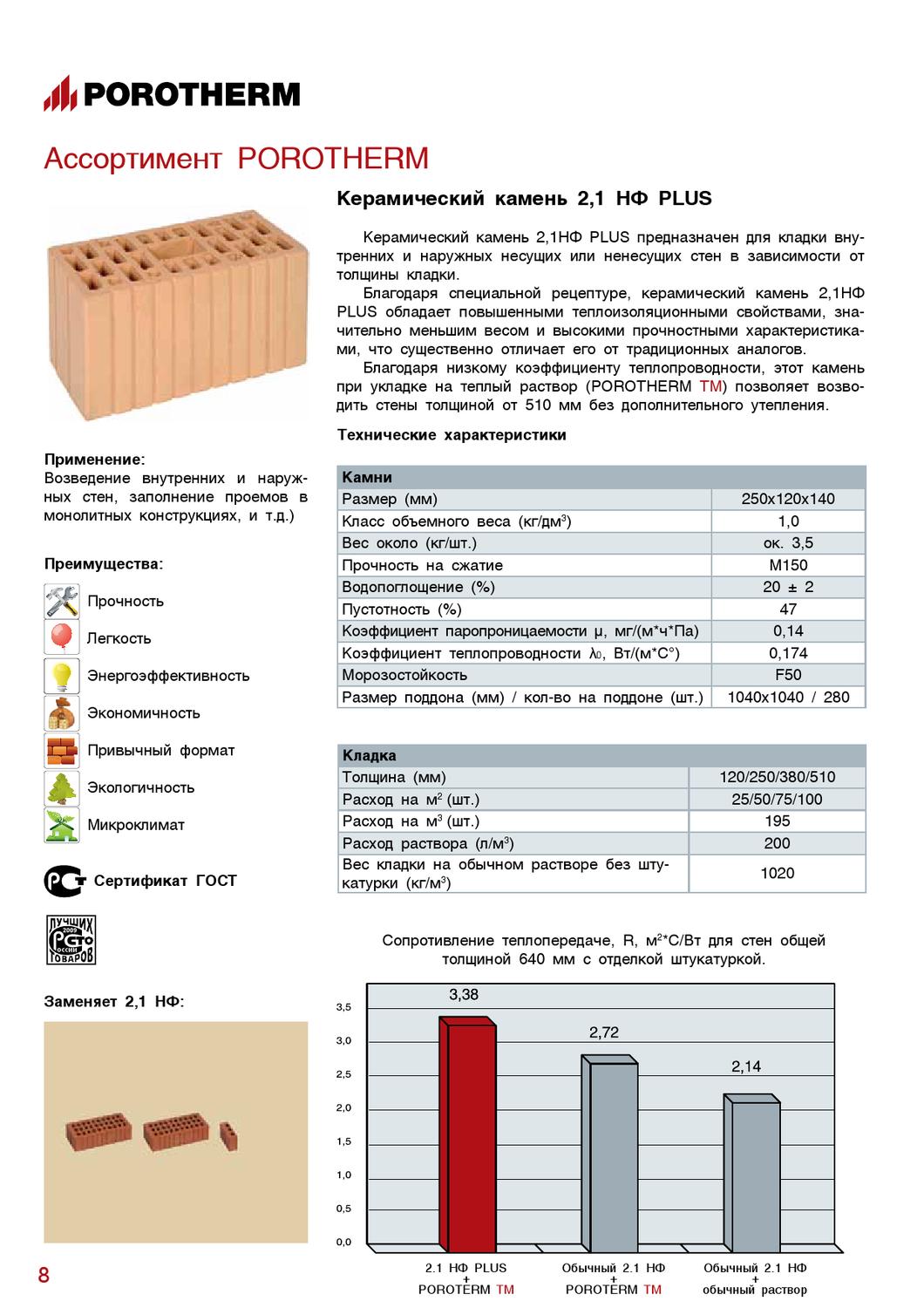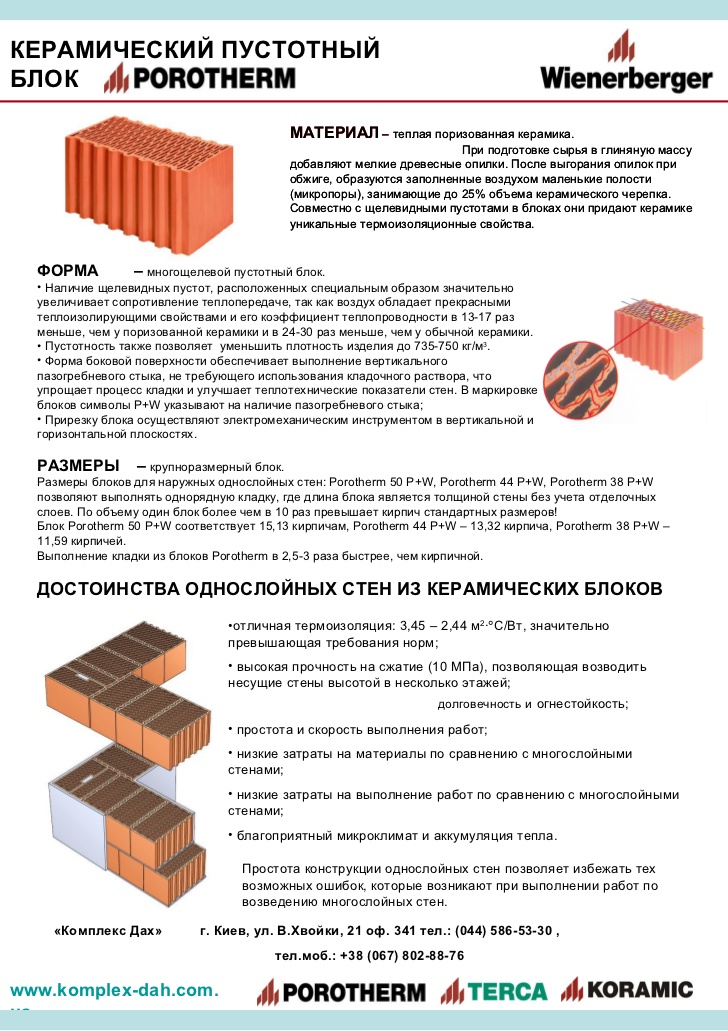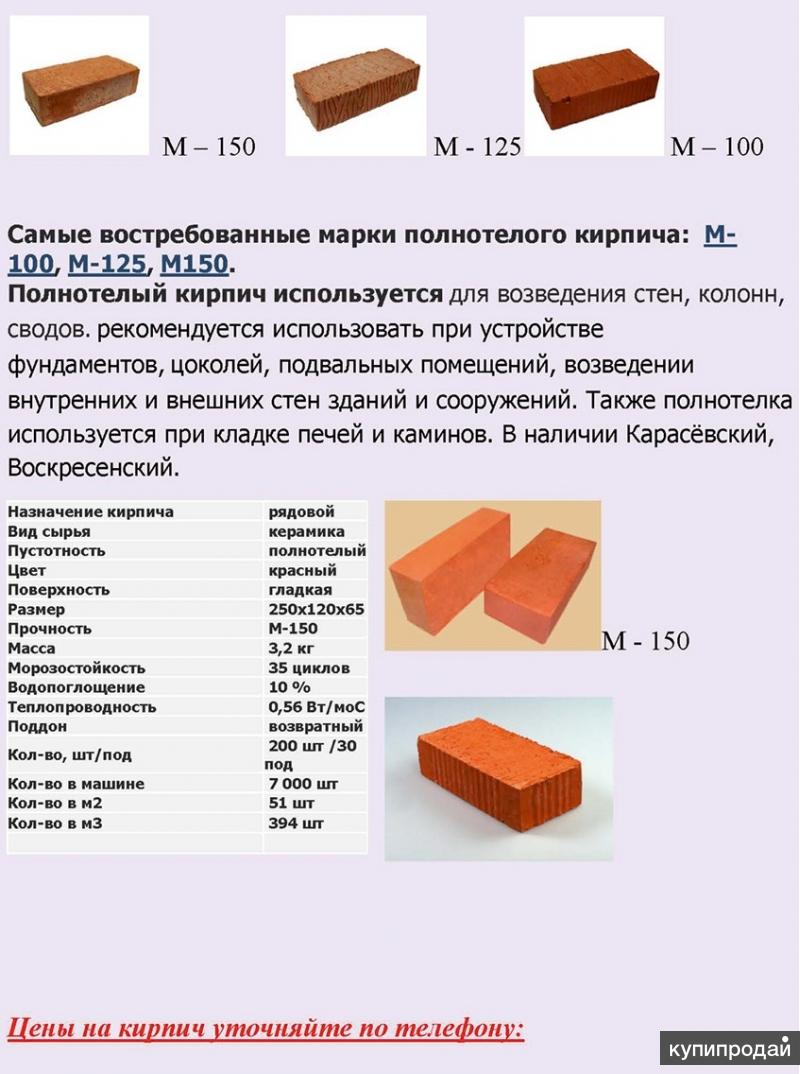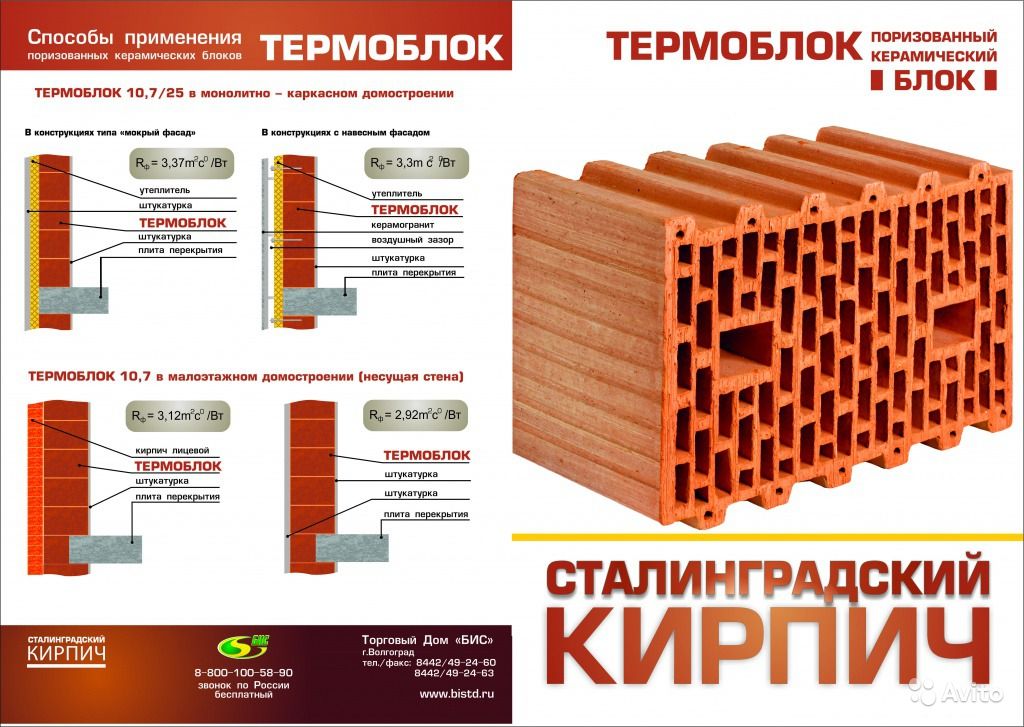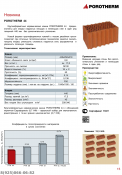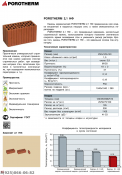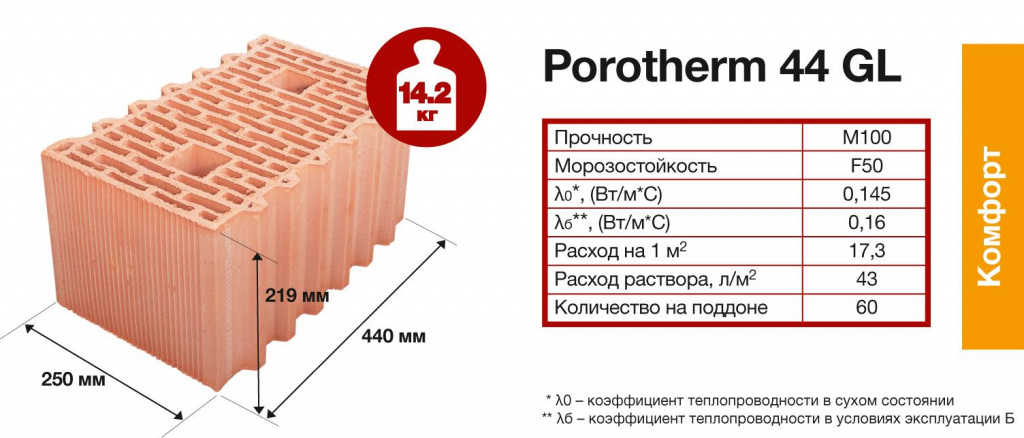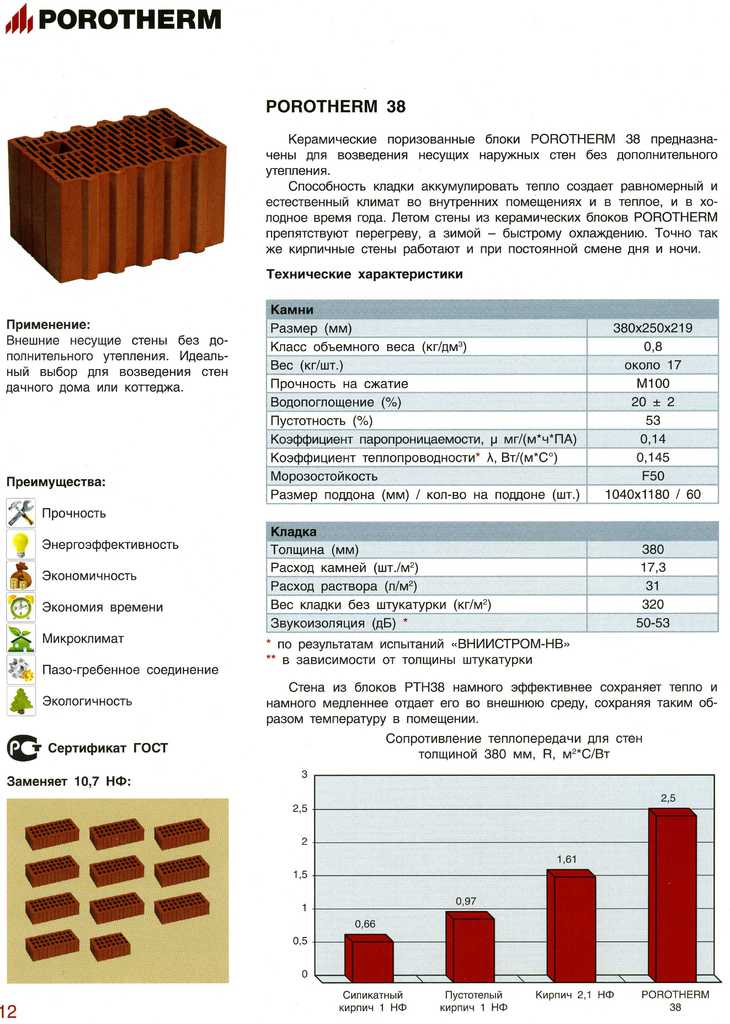Characteristic features of porous bricks
Such a simple production technology makes it possible to obtain a porous building material with unique properties. This product combines the advantages of both red brick and aerated concrete, without the disadvantages that they possess. This building material began to be produced not so long ago, but it managed to win its place in construction. It owes much of its popularity to its high thermal insulation properties. It is its energy-saving properties that are in demand in today's society, which is aimed at saving energy resources.
Externally, a porous brick differs from the usual:
- its porous structure,
- sizes,
- lighter weight, even at larger sizes,
- high thermal insulation qualities.

Various shapes of porous bricks.
Advantages of porous bricks:
There are a lot of hollow cells inside the body, it is they who retain heat, that is, they reduce the energy consumption for heating the building. With a properly selected wall thickness, no additional insulation is required. Insulation, in this case, can reduce the thickness of the walls of the building, but the quality of the thermal insulation will not change
Whereas when using other bricks, insulation is necessary.
No toxic substances are emitted during operation.
Excellent sound insulation complies with SNiP 23-03-2003 on Noise Protection.
Another important quality of this type: it does not overload the foundation. That is, for the construction of a building, it is not required to erect a reinforced foundation.
The durability of the masonry is confirmed by time.
Natural materials are used for production: clay, and sawdust or peat is used as a filler
Formed products are fired. During the firing process, the organic filler completely burns out completely, forming pores inside the product. The resulting porous bricks are called breathable.
The size of the bricks allows you to shorten the construction time.
The consumption of the working solution is reduced.
Foundation costs do not increase.
Reduced building maintenance costs. Its thermal conductivity is characterized by a coefficient of 0.17 - 0.2.
High frost resistance: from 25 to 100 freezes and defrosts. With such procedures, the brick does not crack, does not peel off, and chips do not form on it.
A high degree of fire resistance, which is ensured precisely by porosity. The material can withstand prolonged exposure to fire.
When using double bricks, you do not need to spend money on the exterior decoration of the house, that is, you do not need to paint it from the outside.
Saving finance on construction work.
Warm bricks are produced in 14 types of sizes, such a large assortment allows you to build buildings, the thickness of the walls, which can be from 25 cm to 50 cm. For example, just one block with a size of 250x120x140 replaces two standard brick sizes at once. This makes it possible, instead of a multi-layer laying of the wall, to produce masonry from warm ceramic blocks of large sizes, using a smaller number of them, without using insulation.
Walls built of porous bricks:
- keep the received heat for a long time,
- do not absorb moisture or steam,
- are not affected by mold and fungus.
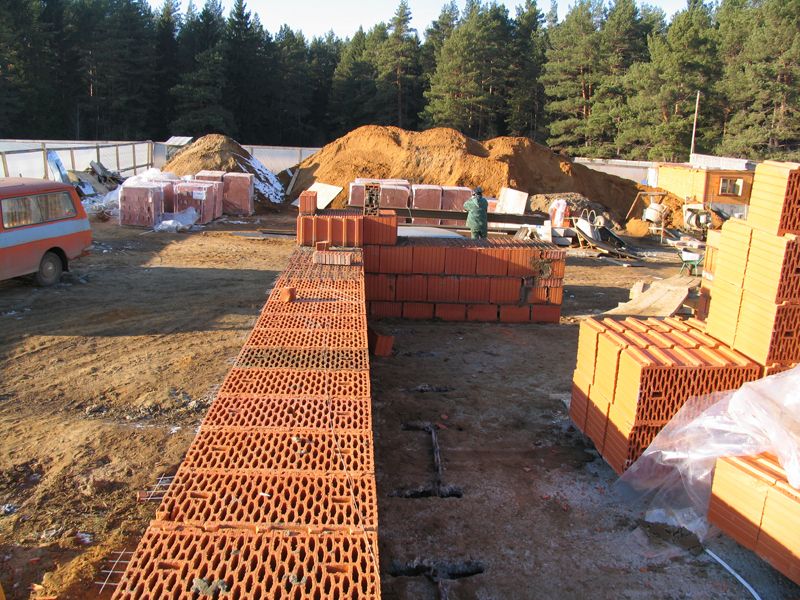
Brick of this type significantly speeds up the construction process and has a positive effect on the preservation of heat in the room.
During the laying of the ceramic warm block, only horizontal joints are connected with mortar. Fewer seams - less heat loss, moreover, the consumption of mortar is saved. What actually happens:
- savings in the construction of the foundation,
- savings in the construction of walls,
- saving cement mortar.
The properties of porous bricks make it possible to use it for the construction of residential buildings and enclosing structures. This new building material has good resistance to aggressive environments. It can be used alone or in combination with other types of stones.
Porous blocks are used for:
- construction of residential buildings;
- internal partitions;
- erection of load-bearing structures.
Types, properties and application
By designation, brick is divided into construction, special and facing. Construction is used for masonry walls, facing - for the design of facades and interiors, and a special one is used for foundations, road surfaces, masonry of stoves and fireplaces.
A narrower specialization is due to the different structure of products.
Solid brick
It is a solid bar with random voids less than 13%.
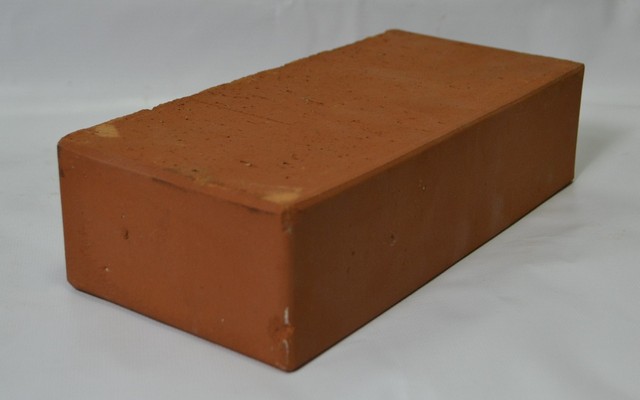
Bricks are corpulent:
Silicate, ceramic - used for the construction of self-supporting walls, partitions, columns, pillars, and so on. Solid brick structures are reliable, frost-resistant, capable of carrying additional loads. Partitions provide good sound insulation with a small thickness, retain a large amount of heat.
In addition, the material is quite decorative and popular with many modern designers. But the high coefficient of thermal conductivity and water absorption forces to build external walls of great thickness or make them three-layer, combining with insulating materials and other types of bricks.
Fireclay - is made of special refractory crushed clay and fireclay powder by firing with an increased temperature regime. It is used for laying out fireplaces, stoves and other structures where fire resistance is required. The specificity of the application has determined a wide variety of product shapes:
- wedge-shaped and straight;
- large, medium and small sizes;
- shaped with profiles of varying complexity;
- special, laboratory and industrial crucibles, tubes and other equipment.
Clinker - made from refractory clays with various additives. Fired at very high temperatures until completely baked. Various components and variability of the firing mode give the bricks increased strength, water resistance and a wide palette of shades from greenish, when fired with peat, to burgundy with charcoal tan. It used to be widely used for paving sidewalks, now it is used in masonry and cladding of foundations. The thermal conductivity of ceramic bricks is quite high.
Hollow brick
The material allows 45% of voids from the total volume, and also differs in shape, structure and location of voids in the bar. The thermal conductivity of a hollow brick directly depends on the amount of air in its body - the more air, the better the thermal insulation.
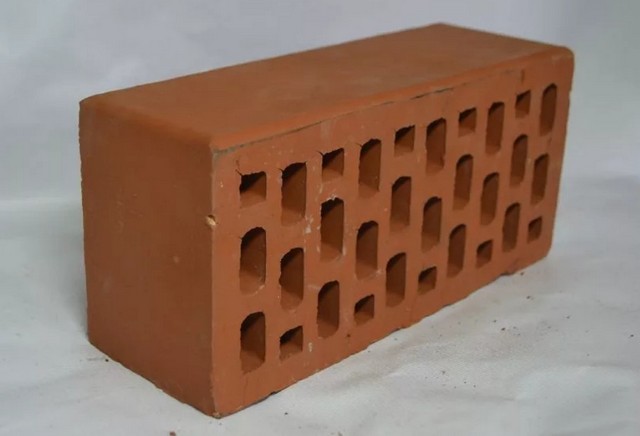
A brick with voids is a block with two or three large through holes, which serve rather to facilitate and reduce the cost, rather than improve thermal insulation. It is used on a par with a full-bodied analogue, with the exception of foundations and other structures that require increased strength.
Slotted brick - the entire body of the block is pierced with holes of various shapes and sizes.
They are:
- rectangular;
- triangular;
- diamond-shaped;
- through and closed on one side;
- vertical and horizontal.
Quite good strength and low thermal conductivity determine its demand for the construction of external walls of residential buildings.
Porous bricks - available in several sizes. In addition to a large number of holes, it has a porous material structure, which is formed when special small fractions added to clay are burned out. Possesses the best set of qualities for the construction of external walls.Strength, low thermal conductivity and large dimensions reduce the construction time by several times, while observing the latest SNiP requirements. Warm ceramics are characterized by the lowest thermal conductivity, but due to their fragility, they have limited application so far.
Facing brick is also hollow, successfully combining artistic and insulation properties.
Table of indicators of thermal conductivity of building materials
| Material name | Thermal conductivity coefficient, W / (m * K) |
| Ceramic block | 0,17- 0,21 |
| Porous brick | 0,22 |
| Ceramic slotted brick | 0,34–0,43 |
| Slotted silicate brick | 0,4 |
| Ceramic brick with voids | 0,57 |
| Ceramic solid brick | 0,5-0,8 |
| Silicate brick with voids | 0,66 |
| Solid silicate brick | 0,7–0,8 |
| Clinker brick | 0,8–0,9 |
Almost always, in the construction of a house, several types of bricks with corresponding characteristics are used for different structural elements.
Colored and figured bricks
This is a special type of facing brick, which is given a special shape, surface relief or a special color to enhance the decorative effect. The relief can be simply repetitive, or it can be processed under "marble", "wood", "antique" (textured with worn or deliberately uneven edges). Shaped bricks are called shaped bricks in another way, which speaks for itself. Distinctive features of figured bricks are rounded corners and edges, beveled or curved edges. It is from such elements that arches, round columns are erected without any special difficulties, and the decor of facades is performed.
Among the enterprises of our region in the field of colored and figured bricks, the palm is again shared by NPO Keramika and Pobeda Knauf. The latter, last year, began the production of engobered bricks (brick of volumetric coloring, resistant to various kinds of influences) of an expanded color range.
Ceramic facing bricks, hollow, colored and brown
Cream front brick, dyed in bulk (Pobeda plant) |
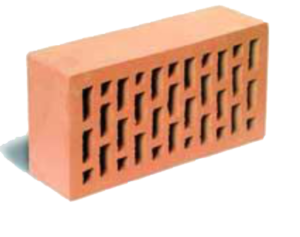
Size (mm): 250х120х65 Weight (kg): 2.4–2.5 Density (kg / m³): 1200–1300 Brand: М150 Frost resistance: F50 Thermal conductivity (W / m ° С) |
| Cream is the original color and warmth of soft cream colors. Cream brick is intended for cladding external and internal walls. |
Facing white brick with textured surface (Pobeda plant) |
|
Size (mm): 250х120х65 Weight (kg): 2.4–2.5 Density (kg / m³): 1200–1300 Brand: М150 Frost resistance: F35, F50 Water absorption: (%) 6–7 Thermal conductivity (W / m ° С) |
| Designed for facing the outer walls of buildings and structures of any number of storeys. The production technology allows achieving color uniformity. |
Facing straw bricks with textured surface (Keramika plant) |
|
Size (mm): 250x120x65 Weight (kg): 2.2-2.5 Density (kg / m³): 1130-1280 Brand: M125, M150 (M175 on request) Frost resistance: F35, F50 Water absorption (%): 6-8 Thermal conductivity (W / m ° C) |
| Designed for facing the outer walls of buildings and structures of any number of storeys. The production technology allows achieving color uniformity. |
Colored front bricks with textured surface (Ceramics plant) |
|
Size (mm): 250x120x65 Weight (kg): 2.2-2.5 Density (kg / m³): 1130-1280 Brand: M125, M150 (M175 on request) Frost resistance: F35, F50 Water absorption (%): 6-8 Thermal conductivity (W / m ° C) |
| Designed for facing the outer walls of buildings and structures of any number of storeys. The production technology allows achieving color uniformity. Color pink, gray, light green, green, yellow, light blue, blue |
Facing brick with a relief surface "Reed", red ("Keramika" plant) |
|
Size (mm): 250x120x65 Weight (kg): 2.2-2.5 Density (kg / m³): 1130-1280 Brand: M125, M150 (M175 on request) Frost resistance: F35, F50 Water absorption (%): 6-8 Thermal conductivity (W / m ° C) |
| Used for facade and interior work. The front surface of the brick resembles reed stalks in texture and allows you to enrich the ceramic masonry with decorative strokes and give it a picturesque expressiveness. |
Facing brick with a relief surface "Oak bark", red ("Keramika" plant) |
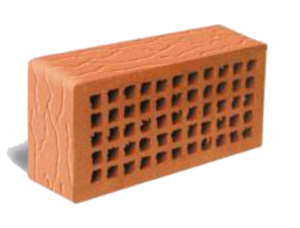
Size (mm): 250x120x65 Weight (kg): 2.2-2.5 Density (kg / m³): 1130-1280 Brand: M125, M150 (M175 on request) Frost resistance: F35, F50 Water absorption (%): 6-8 Thermal conductivity (W / m ° C) |
| Used for exterior and interior work. The texture of the brick surface resembles the bark of a tree, which determines the expressiveness and attractiveness of this material. |
Facing bricks hollow figured red, brown |
|
Size (mm): 250х120х65 Weight (kg): 2–2.2 Density (kg / m³): 1130–1280 Brand: М125, М150 Frost resistance: F35, F50 Water absorption (%): 6–8 Thermal conductivity (W / m ° С) |
| Figured brick is an original material for home decoration, allowing you to make any building individual. The use of shaped bricks avoids labor-intensive cutting operations for conventional facing bricks and provides architects with the broadest opportunities for creating individual architectural elements of facades: rounding and framing window and door openings, erecting arches and columns |
Features and differences between types of bricks
The construction purpose of different brands of bricks is different - these are special bricks, facing and building brands. When building a house, ordinary building bricks are used, for decorating the facades of houses - facing products, and special brands are used for special operating conditions of a brick structure, for example, in a stove or fireplace.
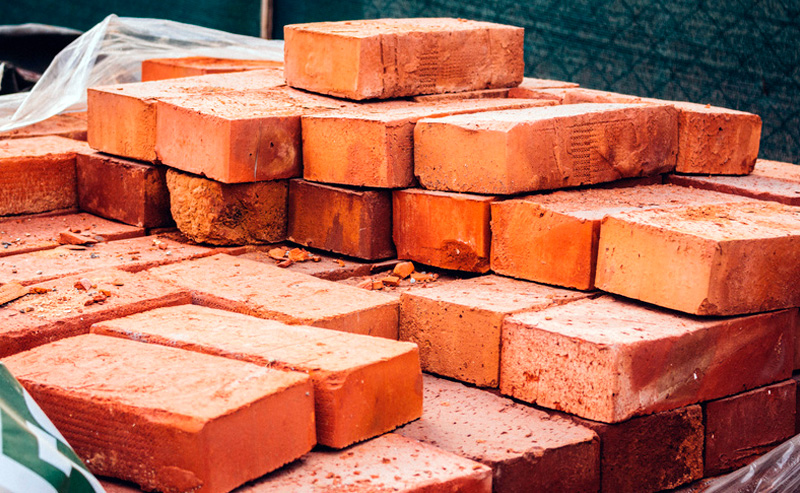 Solid brick
Solid brick
Solid brick products, according to the manufacturing technology, have ≤ 13% air voids: such a brick is suitable for the construction of external and internal walls of a house, columns and pillars, lintels and arches. Solid brick objects can withstand increased stress due to their high compressive strength, bending and frost resistance. The parameters of brick thermal insulation, water absorption properties and adhesion depend on the degree of porosity of the product. This brick has average resistance to heat transfer, so it is recommended to make the walls of the house thick enough (at least 0.5 meters), and to carry out insulation by other means.
Hollow bricks are produced with a void volume of ≤ 45%, so their weight is less than that of standard solid bricks. It is used in the construction of internal partitions, external walls and frames of multi-storey high-rise buildings. The shape of the voids can be through or one-sided (closed from the end), in the form of a circle, square, oval or rectangle. Voids are formed in the vertical or horizontal direction relative to the longitudinal axis of the product.
The voids in an already small piece save almost half of the building material and make the walls warmer. When laying hollow bricks, it is necessary to control the consistency of the cement mortar - it should not spread over the surface and fill the voids that form in the wall, as described above.
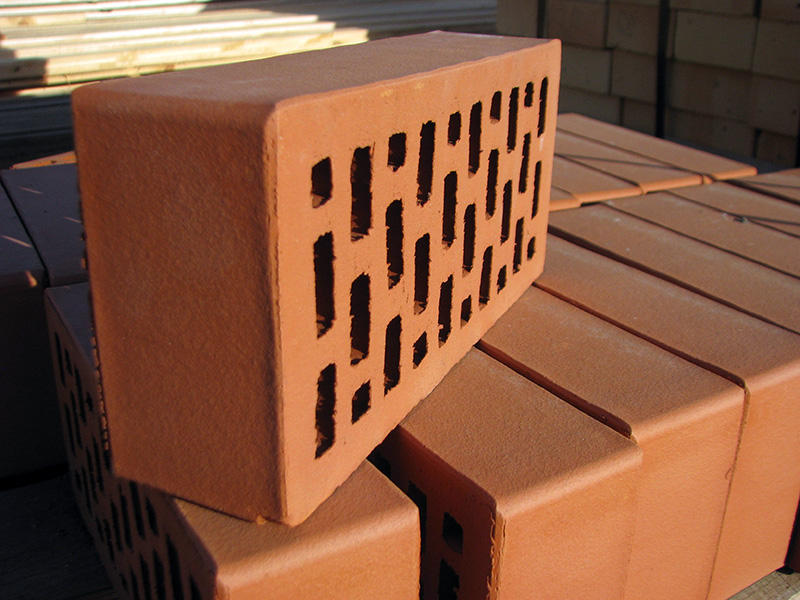 Hollow brick
Hollow brick
The purpose of the facing brick is clear from its name - it is used for facing the facades and side walls of the house. The dimensions of the facing products are the same as for ordinary building bricks (you can also purchase a batch with reduced dimensions), which makes it easier to work with it. Brick for cladding is often made with voids, which improves its consumer characteristics - working with such a brick, you can save on additional thermal insulation of the walls.
 Facing brick
Facing brick
An example of grades of special bricks are heat-insulating and refractory products.Both grades are used in the construction of heating stoves and home fireplaces, as well as industrial smelting furnaces. The material for the production is fireclay clay with special refractoriness properties. At the same time, different manufacturing technologies allow the use of refractory bricks for different operating conditions. For example, a brick with refractory properties can withstand temperatures above 1600 ° C, and heat-insulating brick grades are used in thermal insulation technologies, for example, when heating the outer walls of open-hearth furnaces, as well as to prevent heat loss in buildings. For the construction of the external load-bearing walls of the house, refractory bricks are not suitable - due to the low compressive strength, only internal partitions in the house can be built from it.
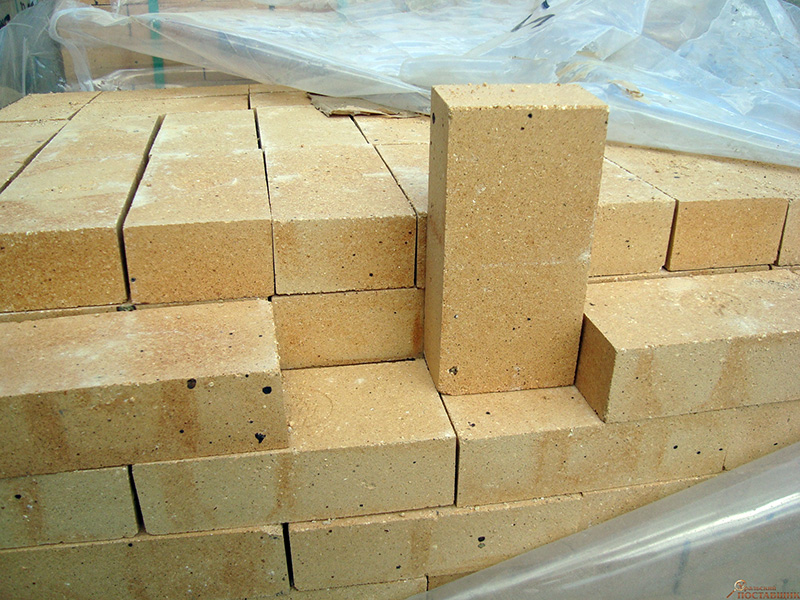 Refractory bricks
Refractory bricks
The main purpose of clinker bricks is cladding the foundations of houses. This brand has a high coefficient of frost resistance, mechanical strength and water absorption, since refractory clay is used for its manufacture. Raw clinker bricks are fired at higher temperatures than conventional bricks.
Major mistakes
So we got to the essence of the story. Since the material is quite new in the modern building materials market, even experienced builders can make inaccuracies and obvious mistakes when working in porous ceramic blocks. Among them:
- Laying porous blocks along the wall with a corrugated, long side. Such laying is not allowed even for the construction of internal walls, because it can break the adhesion of the blocks. In addition, the thermal insulation properties of each block separately in the perpendicular direction are much less, and the plaster for finishing work will take almost twice as much.
- Combining blocks with bricks and other building materials with a higher thermal conductivity is not allowed! This always leads to condensation of moisture on the walls, the appearance of fungi and mold, and so on.
- It is also unacceptable to lay rows of ceramic blocks without bandaging! This will significantly reduce the strength of the masonry.
- Different thickness of seams between individual rows is not allowed. At the same time, the geometry of the walls is seriously disturbed, in the structure of which unevenly distributed loads arise. In this case, thick seams will be potential cold bridges during operation, which will significantly reduce the thermal insulation properties of the walls.
Construction of houses from porous bricks and their advantages
The construction of houses from porous bricks allows you to build a solid and reliable structure. This material can withstand a load of 150 kg per sq. cm. Therefore, buildings of nine floors can be erected from it. Due to this strength, porous bricks can be used in any type of construction.
This brick has convenient dimensions that differ from the standard brick. Porous bricks of various sizes are produced. In this case, the wall thickness of this material will be 250 mm. The speed of building buildings is also high, it can be compared with the speed of building a house from aerated blocks. Any team of builders, even without much experience, has the opportunity to deliver a box of a structure made of porous bricks in just one week.
Porous bricks are lightweight. The volumetric weight of the material is less than 800 kg per cubic meter. meter. This indicator can be compared only with aerated concrete, which is used in the construction of low-rise buildings. Low density reduces the pressure on the foundation, and this makes it possible to build a house from porous bricks on almost any kind of soil.
Due to the low thermal conductivity of bricks, it is called one of the best building materials. Aerated concrete has a similar thermal conductivity. Walls made of porous bricks do not need to be additionally insulated.To comply with energy saving standards, it is necessary to build walls that are at least 40 cm thick.
Buildings made of porous bricks are not afraid of adverse weather conditions and precipitation. The material can withstand exactly the same number of freezes and defrosts as a simple brick. In addition, porous brick is an inert material in terms of its biological characteristics, so it is not susceptible to the formation of fungus or mold. The only exception is the decay process.
Inside buildings, built of porous bricks, there is always a favorable microclimate. This is facilitated by the pores that are present in the building blocks. It is with their help that the natural humidity inside the room is regulated. The house, for the construction of which porous bricks were used, can be compared with buildings built of wood and aerated concrete. Such a building has the highest sanitary and hygienic properties.

Wall construction made of porous bricks
Houses made of porous bricks are distinguished by fire resistance, since this building material, like silicate and clay, does not burn and is able to withstand the effects of open fire for several hours.
The double porous bricks used for the interior and exterior decoration of the building have no restrictions. Finishing work can be carried out using a wide variety of materials. At the same time, a house made of porous bricks does not need to be painted from the outside, since this material is produced in a large assortment of different color shades.
Features of masonry walls made of warm ceramics
It must be remembered that high-quality masonry of large-format ceramic blocks is possible only by the efforts of qualified bricklayers who have mastered the work with this specific material well.
Developers should be aware that warm ceramics cannot be laid on standard cement mortar, which, flowing into voids, reduces its energy-saving qualities. Therefore, when buying blocks, you must immediately purchase a branded glue, which, with a minimum joint thickness (2 mm), guarantees high strength of the masonry and eliminates "cold bridges".
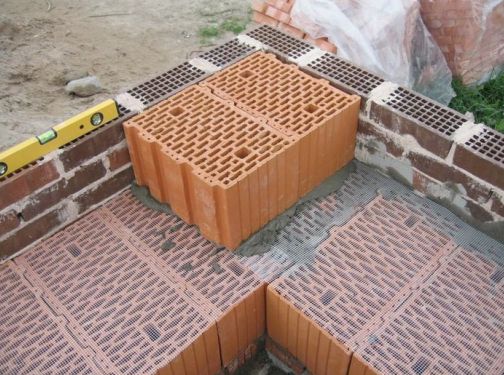
Walls made of warm ceramics are erected with bandaging of vertical seams and using a fiberglass mesh, which is laid every 2 rows of blocks. If the interfloor floors will be mounted from heavy reinforced concrete panels, then a layer of mortar with a thickness of at least 2 cm should be laid on the upper row of masonry and a steel masonry mesh should be sunk in it. This will protect the ceramic blocks from being punctured.
It is important to remember that porous ceramic bricks require attention not only at the masonry stage, but also at the stage of fixing pipes, heating radiators, hanging shelves, mezzanines and other items. Regular fasteners will not adhere to the thin walls of this material
Therefore, you need to use long anchors or "injection" dowels.
Useful video on the topic:
What is important to know before purchasing material
Construction is a rather demanding process. In order for the work to be fast and of high quality, the volume of the material should be correctly calculated. The thickness of the wall will affect the calculated values. Thus, if you want to get a wall with a thickness of 120 millimeters, then you should masonry in half a brick. For a wall thickness of 250 millimeters, you need to lay out the products in one brick. 380 millimeters will be obtained if you lay blocks in one and a half bricks. 510 millimeters can be obtained when laying in 2 bricks. And for a thickness of 640 meters, two and a half bricks should be laid.
Thermal conductivity of masonry
According to GOST 26254, it is determined λ for brick and block masonry. To do this, proceed as follows:
- During the observation period, readings (arithmetic mean) are determined for all thermocouples and tipmeters.
- For the surfaces of masonry, which are located inside and outside buildings and structures, the weighted average temperature is calculated based on the test results. The area of the mortar joints of the horizontal and vertical sections, as well as the area of the butt and spoon sections, are taken into account.
- Determine thermal resistance for masonry.
- The thermal conductivity of the masonry is calculated from the thermal resistance value.
The use of porous blocks in the construction of residential buildings

If you use the material described in the article, then you can build a house that will be distinguished by reliability and durability. The products are capable of withstanding a load of 150 kilograms per square centimeter. It is this characteristic that makes it possible to build buildings, the height of which is equivalent to 9 floors. Due to its similar strength, porous bricks can be used in any type of construction.
The manufacturer made sure that the blocks have the most convenient dimensions, they differ from ordinary bricks. On sale you can find products of various sizes, the thickness of the walls will be 250 millimeters. The speed of construction can be compared with the speed that can be achieved when using gas blocks. One team of builders, even without professional experience, will be able to erect a building box using the described brick in one week.
Execution of channels and niches
Channels and recesses should not compromise the stability of the wall and should not run over lintels or other structural parts embedded in the wall. The dimensions of vertical grooves and niches in the masonry, permissible without additional assessment by static calculation, are given in table. 5.
|
|
| Sizes of horizontal channels and niches in masonry, permissible without calculations |
Horizontal and oblique channels are undesirable. If they cannot be avoided, then they should be at a distance of at least 1/8 of the height of the room from the lower or upper surface of the floor. Their depth, permissible without additional assessment by means of static calculations, is indicated in table. 6. If one of the indicators exceeds the values indicated in the tables, then the strength of the wall in compression, bending and shear strength must be checked by calculation.
|
|
| Dimensions of horizontal and diagonal channels in masonry, permissible without calculations |
The maximum depth of a canal or niche includes the depth of any opening made during the construction of the canal or niche. As for the additionally punched vertical channels that rise above the floor level by no more than 1/3 of the room height, a depth of up to 80 mm and a width of up to 120 mm are permissible if the wall thickness is greater than or equal to 225 mm. The horizontal distance between adjacent channels or channel and the niche or opening must be at least 225 mm. The horizontal distance between two adjacent niches located on one or both sides of the wall should be twice the width of the larger niche. The total width of channels and niches should not exceed the length of the wall multiplied by 0.13. The maximum depth of a canal or niche includes the depth of any opening made during the construction of the canal or niche. The horizontal distance between the end of the channel and the hole must be at least 500 mm. The horizontal distance between adjacent channels of limited length, laid on one or both sides of the wall, must exceed two channel lengths. For walls more than 115 mm thick, a channel 10 mm thicker than usual is allowed if it is cut to the required depth using special equipment. If the channels are cut with the help of special equipment, then the channels on both sides of the wall can be deepened by 10 mm only if the wall thickness is not less than 225 mm. The width of the channels should not be more than 1/2 of the thickness of the remaining wall. Manual gouging of channels in masonry with a hammer and chisel is slow and laborious.To reduce labor intensity and speed up work, we recommend using special electrical equipment for channeling channels, which can be purchased at specialized power tool stores.
Read the continuation in the article - Construction ceramic houses porous bricks (blocks), part 2
Comparison of Ceramic Warm Block with Competitors
The ceramic warm block can withstand a load of 150 kg per sq. see This indicator allows you to use it for the construction of a building with a height of nine floors. Different block sizes make it possible to select the desired parameter for each specific building. This increases the speed of construction. In addition, high-class specialists are not required for its installation.

Construction of the walls of the building from porous bricks.
The volumetric weight of porous bricks is about 800 kg / m 3. Aerated concrete has similar indicators, but it is used for the construction of low-rise buildings. The low weight of the brick does not produce much pressure on the foundation, therefore this fact makes it possible to build houses using porous stone on almost any soil.
Ordinary clay and sand-lime bricks of different brands also have high reliability indicators, similar to the basic brands of porous bricks. But these materials do not have the same characteristics that warm keramo stone gives. The technology of erecting walls from porous bricks requires laying cement mortar only in a horizontal direction. Vertical fastening is provided by a special groove-comb system. The thickness of the fastening seam is approximately 2 mm, that is, the cold bridge is minimized for this calculation. The speed of the construction process is comparable to the speed of buildings made of gas blocks.
Pros of using porous stone
Buildings built from this material do not require additional insulation due to its low thermal conductivity. In addition, in order for the building to meet energy conservation standards, the thickness of the walls can be at least 40 cm. Aerated concrete has similar thermal conductivity qualities.
Due to the porous structure of porous stone, a pleasant microclimate for living is created in houses built with its use. The porous base of the brick provides natural moisture inside buildings. Houses built of porous bricks are similar in terms of comfortable living to houses built of wood or aerated concrete.

The residential building of the Edalgo complex was built using porous stone.
Houses built of porous bricks keep warm in the winter and keep them pleasantly cool in the summer.
The fire resistance of this material is compared with the fire resistance of silicate and ordinary bricks. Porous building material can withstand fire for several hours.
Disadvantages of porous bricks
The cost of warm ceramic bricks is slightly higher than ordinary bricks. Prices are determined by the brand of the product: the higher the brand, the higher the cost of the brick. The cost of this material is twice that of other types of bricks. The high price discourages owners from buying this material. But, if you calculate the cost of heaters, decorative finishes, then the financial costs will not be so frightening.
vote
Article Rating
Advantages and disadvantages
The porous ceramic block offers numerous advantages that drive the high demand for such products.
The main advantages of porous bricks include several factors.
- High strength of the material.
- Small mass. Due to the minimum weight, the load on the foundation of the structure is noticeably reduced, due to which there is no need to equip a powerful foundation.
- The ability to choose the optimal size for any scale of construction.Manufacturers produce ceramic blocks of the following standard sizes: 250x120x140, 250x380x219, 510x250x219 and 380x250x219 mm.
- Environmental friendliness. This type of blocks is made from natural raw materials, so that they do not emit toxic substances during operation.
- Excellent heat and sound insulation.
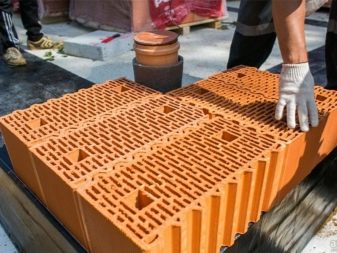
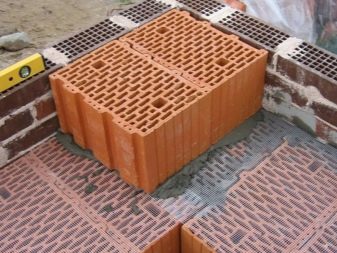
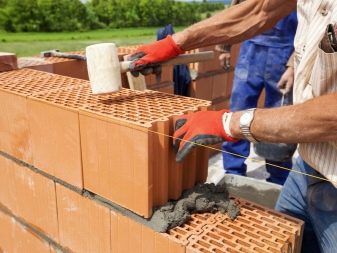

- Resistance to negative external influences. Buildings made of porous bricks are "not afraid" of atmospheric precipitation. In addition, they can withstand the same number of defrosting and freezing cycles with conventional bricks.
- Good sanitary and hygienic performance. On objects built from porous blocks, mold and mildew do not form.
- The presence of a tongue-and-groove system on the side parts of the bricks, ensuring their reliable connection without the use of cement mortar.
- Refractoriness. Porous brick not only does not support the combustion process, but is also able to withstand the effects of flame for several hours.
